Apeldoorn, NL, 5th October 2013
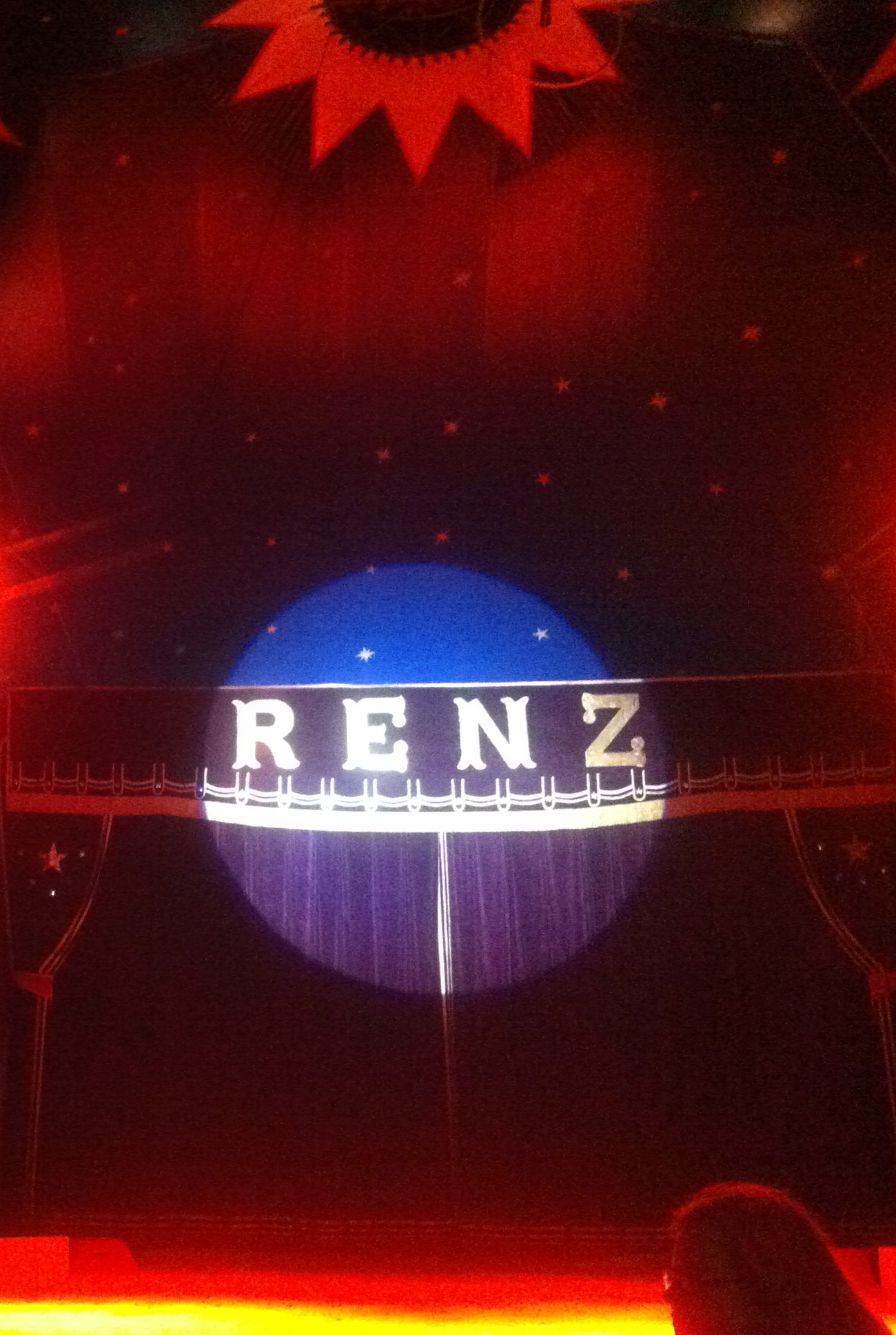
The name Renz appears in many of the circus history books, with the circus begun originally in Berlin by Ernst Jacob Renz in 1842. After opening several permanent circus buildings in German cities, fortunes took a turn for the worse and, in 1897, Ernst’s son Franz was forced to shut down the company.
In 1940, Ernst’s great-nephew Bernhard re-established a circus with the family name, and his descendants have also branched out with their own shows creating quite a dynasty. In the Netherlands, both Renz International, and Renz Berlin now tour regularly (as well as a confusingly un-related Circus Herman Renz, set up by Arnold van der Vegt in 1911, who changed their name during the Second World War to ensure survival playing to German audiences in the occupied Netherlands).
My excitement tingled as I drove towards Apeldoorn for the performance, unsure of how I would find this traditional format, complete with horses, camels and elephants. Whilst writing for this site, I am a firm believer in the literal meaning of ‘contemporary circus’; that is, circus of the moment, rather than something defined by a particular set of artistic principles. In spite of this, the majority of my viewing experience comes from the performance categories commonly referred to as ‘new’ and ‘contemporary’ circus, which have moved away a from traditional compilation of disparate acts into more concept driven production. (See my definitions here.)
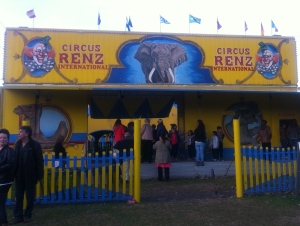 The smartly painted trucks – canary yellow and sky blue to match the striped chapiteau – advertise the Circus Renz International and lead the gathering crowds around to the main entrance where the ticket office sits, alongside separately fenced fields of horses, camels, and three Indian elephants. The enclosures appear unmanned by circus personnel and, at first, I am concerned by the small children joyfully feeding leaves and twigs from a nearby tree into the curling trunk of one huge animal; then I realise that if the creature found this attention distasteful, she needn’t accept the offerings and transfer them to her mouth, and could easily move away beyond the children’s reach. Indeed, if she so desired, the elephant could have breezed through the thinly strung barrier and taken matters into her own hands, so to speak. Sometimes, in trying to do the right thing to protect others, we make the mistake of forgetting their own free will and so, once satisfied that the animals seemed content, I move along to collect my ticket.
The smartly painted trucks – canary yellow and sky blue to match the striped chapiteau – advertise the Circus Renz International and lead the gathering crowds around to the main entrance where the ticket office sits, alongside separately fenced fields of horses, camels, and three Indian elephants. The enclosures appear unmanned by circus personnel and, at first, I am concerned by the small children joyfully feeding leaves and twigs from a nearby tree into the curling trunk of one huge animal; then I realise that if the creature found this attention distasteful, she needn’t accept the offerings and transfer them to her mouth, and could easily move away beyond the children’s reach. Indeed, if she so desired, the elephant could have breezed through the thinly strung barrier and taken matters into her own hands, so to speak. Sometimes, in trying to do the right thing to protect others, we make the mistake of forgetting their own free will and so, once satisfied that the animals seemed content, I move along to collect my ticket.
Everything is neat and well maintained, from the evocatively scented popcorn and refreshments stand to the clean and simple toilet block (although four cubicles were hardly enough for tonight’s packed out house). Ushers, stage-hands, and pre-costumed performers help out front-of-house in spangled Sgt Pepper style military outfits. A smart seller of glowing fibre-optic toys, also in the glitzy Beatles-esque parade uniform, passes through the bustling crowds eager to find their seats, and the anticipation builds as more seats are carried ringside for the seemingly unstoppable flow of people through the curtained archway that leads into the big top.
 Inside of the brightly striped yellow and blue tent, the canvas is coloured the darker blue of a night sky, complete with stars. The sawdust of the ring is warmly lit under the elegent purple and gold artists’ entrance. WIth a burst of bold music and flashing lights, the show begins.
Inside of the brightly striped yellow and blue tent, the canvas is coloured the darker blue of a night sky, complete with stars. The sawdust of the ring is warmly lit under the elegent purple and gold artists’ entrance. WIth a burst of bold music and flashing lights, the show begins.
Martijn Hendrikx takes the role of unobtrusive MC, opening the evening with ‘help’ from his clown assistant Pascalino, and then heading to the sidelines where he makes his mic’ed credit announcements following each act, returning centre stage for transitional interlude skits – in which the visual gag of Pascalino’s domineering height against Martijn’s own small slight build helps the sometimes tired comedy routines.

Photo: MartijnH, Circus Renz International
The pace is set as 6 Appaloosa horses gallop into the ring and then settle into a short liberty act, looking regal in their decorative leather harnesses and feathered headbands with minimal apparent instruction from trainer Franz Renz Jr. I am struck by the impact they have; we see horses all the time, but never with all their animal power and grace so freely exhibited in such close proximity. The gentle accompanying musk emphasises their surprise exoticism.
A quick-change double-act from Duo Maya and Yuri Gusev has some funny moments in their flirty one-upmanship, and the humour works best in the subtle nuances of body language and expression, rather than the overly-used extravagant theatrical gestures. Unfortunately, a well-stuctured build in pace and intensity peters out before a true climax.

Photo: MartijnH, Circus Renz International
Clown Pascalino presents a tongue-in-cheek tiger-training entrée with an audience member’s assistance, and then our laughter becomes a collective ‘aaaahh’ – as much for young Bernardo Renz in his green Beatles outfit as his spirited spotted shetland ponys, performing a miniature liberty act to ‘Great Balls of Fire’. The cute factor is maximised with their posing, heads rested over their neighbours’ neck, watching us with big, long-lashed eyes.
A long pause suggests the rig has not been reset from this afternoon’s matinee, and when the lights return, the hoop which had been hanging above the ring has indeed been exchanged for a set of silks. The white fabric lends Germano Renz added grace in his aerial straps technique, and we particularly enjoy an amused superman pose. Descending to the ground every now and again for an applause break, the act develops into wraps and drops, finally lit to cast a dramatic spotlit shadow on the back curtain.
 The next act is a pleasant surprise outside of the expected circus fare; as a tango begins to play, an elderly couple of two dancing puppets appear. As we notice one of the old folk has real feet, suspense mounts (along with our awe at the technical expertise, wonderfully sparkling eyes of the female puppet, and energetic can-can) before the secret is revealed and Maya takes her bow.
The next act is a pleasant surprise outside of the expected circus fare; as a tango begins to play, an elderly couple of two dancing puppets appear. As we notice one of the old folk has real feet, suspense mounts (along with our awe at the technical expertise, wonderfully sparkling eyes of the female puppet, and energetic can-can) before the secret is revealed and Maya takes her bow.
The beauty of a programme like this is the element of surprise, never knowing what to expect next; no less with Pascalino’s performing ducks who win our hearts as they are herded in and out of a simple slalom. Unfortunately, the positioning of the act’s climax near to the ring-side means a lack of visibility that causes many of the audience to miss the final trick; we do, however, enjoy the comedy of a duck who doesn’t want to return to his cage, indicating either a piece of clever direction or a well improvised accident.
Next come the dogs, who jump and dance over their trainer (sexy tomboyish Miss Skarlett Renz, assisted by brother Bernardo) and each other, tails wagging for all they’re worth, apparently having as much fun as their charmed audience. When they attempt to ride on the backs of a couple of Shetland ponies though, the stands yield more gasps of concern than adoration, with several unsuccessful attempts that leave us (and the ponies) noticeably uncomfortable – although the lovable canines seem unperturbed.
I wonder whether the extended periods of blackout and music for ring adjustments are a ploy to try and build anticipation for the next number, but personally find my attention and investment in the show dissipate as the energy drops.
It rises again for vibrant Ernita Ronzalli (neé Gusev) in a neon fringed leotard, diamanté jewellery and winning smile, who enlivens a common hula hoop act with an aerial element as she is hoisted into the air still spinning three hoops.
The act closes on the charismatic Benjamin Mc Allister, who brings a childlike joy and innocence to his accomplished juggling; after a sequence of 5 ball patterns and pirouettes, he shares a sense of humble pride at 7 balls, then moves onto some very fast work with up to 6 sparkling clubs. Pfeiffer retains his composure and good humour despite a couple of drops, and receives the most vocal audience appreciation so far, before the arena darkens and we watch glowing, colour changing clubs dance from his hands. Here is a performer who clearly loves his job, and shares that magic with us.

Photo: MartijnH, Circus Renz International
During the interval there is an opportunity for children to take pony rides around the ring, or to sit atop one of the elephants. As I return to my seat, a tightwire is being rigged, and the second half begins with a focused Georgina Riviera, whose orange spangled costume shows her bra strap, and whose limited repertoire is not an strong opener.
The voltige which follows from Anthony Renz is more impressive and, as he develops a juggling routine standing on his horse’s pad, we see some unusual skill. Assisted by his earnest young brother Bernardo, he causes us to catch our breath in his attempts to reprise a duo 6-club toss whilst remaining atop his cantering mount; there are several reminders of the inherent liveness and potential for failure that mark a circus act, before the final fire-juggled finish and slick rolled dismount.
Lightening the dramatic mood, Pascalino presents a very funny and original kazoo routine with two audience members; the award-winning clown is at his best when communicating through his eloquent non-verbal vocalisations.
Franz Renz Jr returns to present three proud Camels with their jiggly double humps, who are joined by three pale demure horses in a mixed Liberty act with an Arabian flavour.
Ernita and her husband Germano reappear in stern rockers’ leathers to a soundtrack of Depeche Mode, launching into some fast and fierce manipulation of giant metal frames as Duo Ronzalli. As with the rest of the performance, the music links aren’t smooth, but the energy and pep of the chosen tracks aids in the audience’s anticipation.
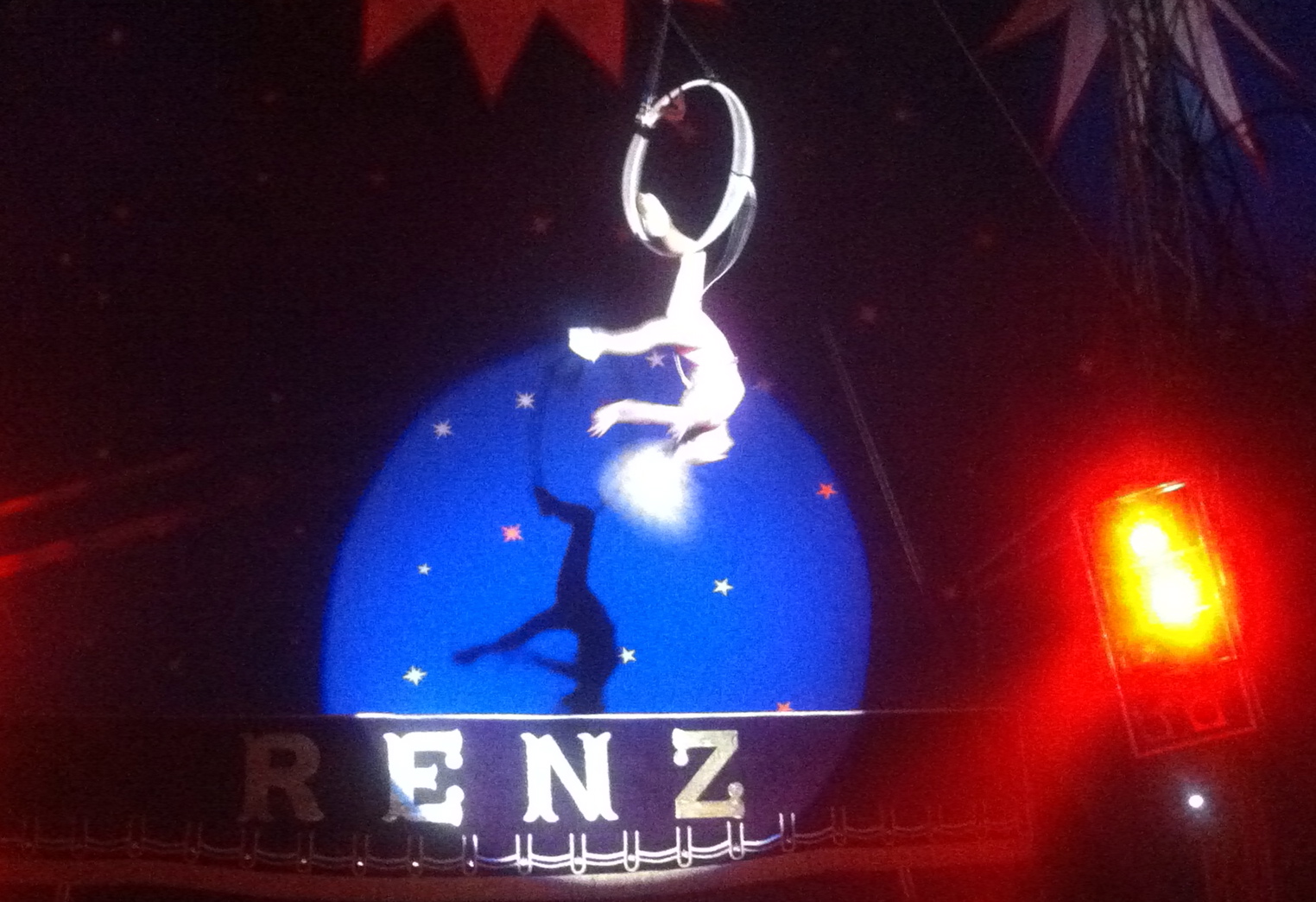
The aerial hoop has been returned to the overhead rig, and is now lowered for Skarlett Renz’ dynamic and fast paced routine. The sound-system pelts ‘I will survive‘ through the speakers, and the sentiment seems inevitable with the safety belt prominently fastened around her waist. Nevertheless, the speed at which the energetic Skarlett is swung and spun around the top, whilst manoevering through a swift series of elegant poses, keeps the thrill alive.
The grand finalé is, of course, circus owner Franz Renz with his three trained elephants. I feel I have to agree with critic David Lewis Hammarstrom in his opinion that the animals in their own majestic right are a powerful show, and that tricks like having them sit, or climb on each others’ backs, are a little demeaning and embarrassing to watch. Much more impressive is the final exit, after bows have been taken from the company, when one great elephant lifts a small boy picked from the audience on his trunk, and carries him across the ring!

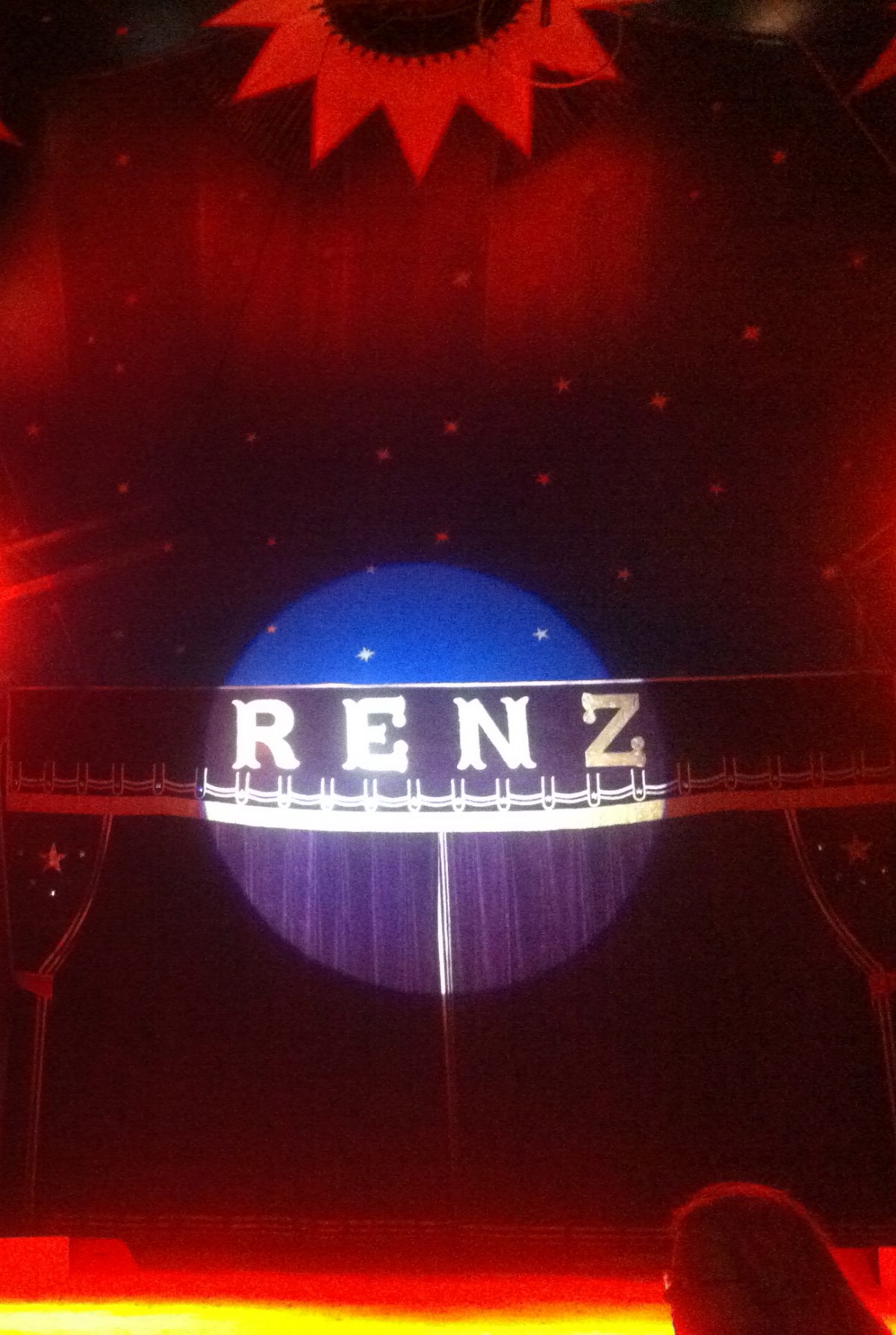
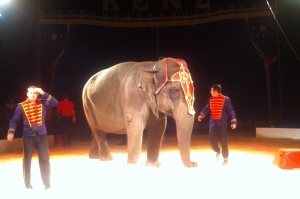

UPDATED 17/10/2013 with full names of performers as reported in an email from company manager Martijn Hendrikx
Writing circus reviews is true investigative journalism! As no programmes are handed out, and the website didn’t list names, I had to scour Dutch and German websites – with the help of GoogleTranslate – cross-referencing as many names as I could (don’t think I did too bad of a job, but good to have the gaps filled in!)
Really interesting points you have noted, regards for putting up.